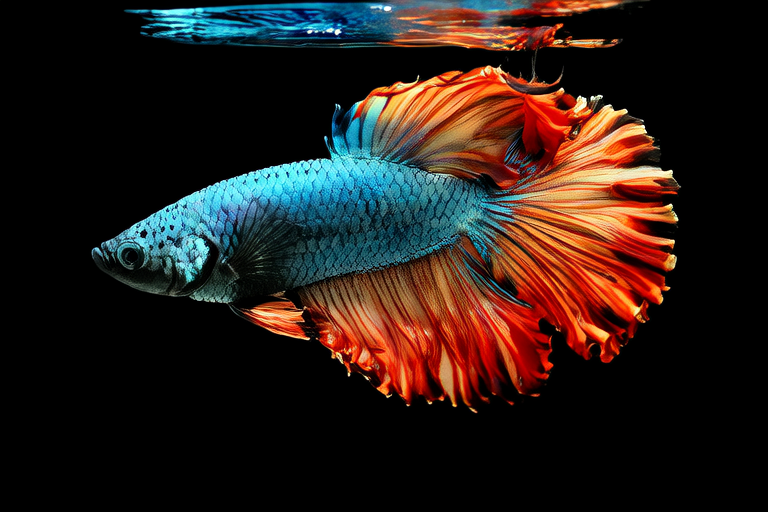The Colorful World of Betta Fish: A Visual Journey Through Tails and Scales
Betta fish, often called Siamese fighting fish, have captivated the hearts of aquarium enthusiasts for decades. These small but strikingly beautiful creatures are renowned for their vibrant colors and elaborate fins. The popularity of betta fish lies not only in their appearance but also in their relatively low maintenance requirements, making them ideal for beginners and seasoned aquarists alike.
The Diversity of Tail Shapes and Scale Patterns
Betta fish come in a wide array of tail shapes and scale patterns, each contributing uniquely to their aesthetic appeal. The most common tail types include the Veil Tail, which features long flowing fins; the Halfmoon, known for its almost perfectly round tail fin that fans out at 180 degrees; and the Crowntail, characterized by its distinctively spiky, frilly edges. Additionally, the Delta and Double Tail varieties offer unique variations in finnage. Each tail shape adds a distinctive charm, transforming your aquarium into a living canvas.
Scale patterns further enhance the visual allure of bettas. From the classic solid coloration to intricate marbling and stunning metallic hues, there’s a pattern to suit every taste. Solid-colored bettas can be found in shades ranging from deep blue and electric green to fiery red and elegant black. Marbled bettas display a blend of two or more colors, creating mesmerizing patterns across their scales. Metallic bettas, on the other hand, possess a shimmering sheen that changes under different lighting conditions, adding an element of mystery and elegance to any aquarium.
Care Requirements for Maintaining Health and Vibrancy
Tank Conditions
Creating an optimal environment for your betta fish is crucial for their health and longevity. A well-maintained tank ensures that your betta remains vibrant and active. While bettas can survive in smaller containers, they thrive in larger tanks that provide ample space for swimming and exploring. A minimum tank size of 2.5 gallons is recommended for a single betta. Ensure the tank has a filtration system to maintain water quality, and consider a heater to keep the water temperature stable between 76-82°F (24-28°C).
Adequate filtration helps to remove waste and excess food, preventing harmful toxins from building up in the water. It’s important to choose a filter that matches the size of your tank and provides gentle water flow to avoid stressing your betta. Additionally, regular water changes, typically 25% weekly, are essential to maintain water quality and prevent diseases.
Diet
Feeding your betta fish a balanced diet is key to keeping them healthy and vibrant. In the wild, bettas primarily feed on insects and insect larvae. In captivity, they can thrive on a diet of high-quality betta pellets, flakes, and frozen or live foods such as bloodworms, brine shrimp, and daphnia. It’s advisable to vary their diet to ensure they receive all necessary nutrients. Feed your betta twice daily, offering just enough food that it can consume within two minutes to prevent overfeeding.
Common Health Issues
Despite their hardiness, bettas can still face health challenges. Common issues include fin rot, a bacterial infection that causes fins to fray and disintegrate, and ich, a parasitic disease that appears as white spots on the body and fins. Regular observation and prompt action are vital in managing these conditions. If you notice signs of illness, isolate the affected fish and consult a veterinarian specializing in aquatic animals for appropriate treatment.
The Emotional Bond Between Betta Fish Owners and Their Pets
The bond between betta fish owners and their pets is often profound. Watching a betta fish swim gracefully through its tank can bring a sense of peace and tranquility to any home. Many owners find solace in the serene presence of their bettas, especially during stressful times. The vibrant colors and flowing fins of these fish create a captivating spectacle that can uplift one’s mood and provide a momentary escape from daily pressures.
Betta fish are intelligent creatures capable of recognizing their owners. They may respond to familiar faces by swimming closer to the glass or even displaying certain behaviors when they anticipate feeding time. This level of interaction fosters a deeper connection between owner and pet, enriching the lives of both parties. For many, caring for a betta fish is not just about maintaining an aquarium; it’s about nurturing a relationship that brings joy and companionship.
